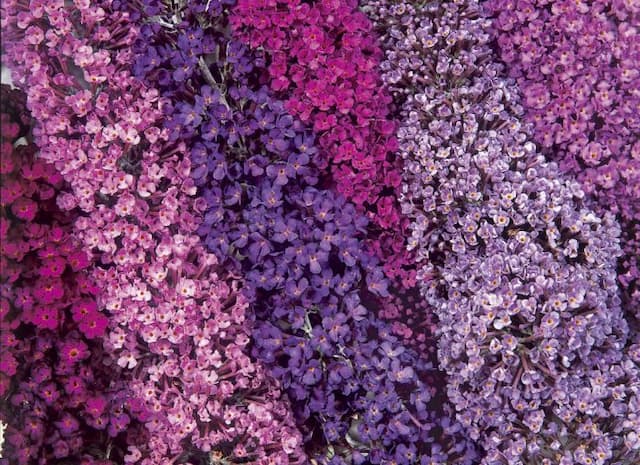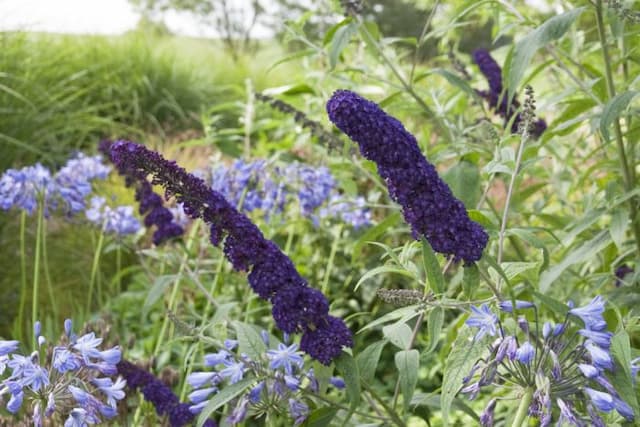Butterfly Bush Buddleja davidii 'Glasnevin Hybrid'

ABOUT
The 'Glasnevin Hybrid' is a variant of the butterfly bush, characterized by its attractive appearance that appeals to gardeners and butterfly enthusiasts alike. The plant features long, arching branches that bear lance-shaped leaves which are green to a grayish-green in color, exuding a lush appearance. During its blooming season, it is adorned with copious amounts of conical flower spikes, providing a vibrant display of tiny, closely-packed flowers. These blossoms are noted for their rich, purple hue, although the term 'Glasnevin Hybrid' may imply some variation in color, potentially ranging from blue to magenta. The flowers possess a sweet, honey-like fragrance that is particularly effective at attracting a variety of pollinators, including butterflies and bees. Moreover, the butterfly bush's blooms emerge in profusion from early summer to autumn, repeatedly gracing the garden with their color and perfume. Its general form is one of abundance and vitality, contributing to its popularity as a striking feature in many landscapes. Despite the absence of information on its exact dimensions, the butterfly bush is often considered a substantial presence, shaping the visual structure of spaces where it is introduced.
About this plant
 Names
NamesFamily
Scrophulariaceae
Synonyms
Butterfly Bush, Summer Lilac, Orange Eye
Common names
Buddleja davidii 'Glasnevin Hybrid'.
 Toxicity
ToxicityTo humans
The Butterfly Bush (Buddleja davidii 'Glasnevin Hybrid') is not commonly regarded as a toxic plant to humans. Generally, it doesn't pose a risk of poisoning if touched or ingested. However, it is always advisable to exercise caution and avoid ingesting plant material that is not meant for consumption, as individuals may have varying sensitivities, and it could potentially cause mild stomach upset or an allergic reaction in some people.
To pets
The Butterfly Bush (Buddleja davidii 'Glasnevin Hybrid') is generally considered to be non-toxic to pets. It is not known to cause serious harm if pets consume parts of this plant. Nevertheless, as with any non-food plant, ingestion can potentially result in gastrointestinal upset, such as vomiting or diarrhea, particularly if consumed in large quantities. Always monitor your pets around plants and consult a veterinarian if you observe any adverse reactions.
 Characteristics
CharacteristicsLife cycle
Perennials
Foliage type
Deciduous
Color of leaves
Green
Flower color
Purple
Height
10 feet (3 meters)
Spread
10 feet (3 meters)
Plant type
Shrub
Hardiness zones
5
Native area
China
Benefits
 General Benefits
General Benefits- Attracts Pollinators: Buddleja davidii, commonly known as Butterfly Bush, is known to attract butterflies, bees, and other beneficial insects to the garden.
- Drought Tolerant: Once established, it has good drought resistance, making it suitable for xeriscaping or gardens with low water availability.
- Easy to Grow: Butterfly Bush is generally easy to care for and can thrive in a variety of soil types, as long as they are well-drained.
- Fast Growing: It can grow rapidly, providing quick coverage or filling in spaces in the garden.
- Ornamental Value: With its spikes of colorful, fragrant flowers, Butterfly Bush adds aesthetic value to landscapes.
- Privacy Screen: Its bushy growth habit can be used to create privacy screens in the garden or landscapes.
- Wildlife Habitat: The plant can serve as a habitat for various species of butterflies and other wildlife, aiding in biodiversity.
 Medical Properties
Medical PropertiesThis plant is not used for medical purposes.
 Air-purifying Qualities
Air-purifying QualitiesThis plant is not specifically known for air purifying qualities.
 Other Uses
Other Uses- Artists' inspiration – Buddleja davidii, also known as butterfly bush, has striking blooms that can serve as an excellent subject or inspiration for artists, including painters and photographers who are drawn to its vibrant colors and attractiveness to butterflies.
- Natural dye – The flowers of the butterfly bush can be used to create a natural dye for fabrics or yarns, yielding shades of purple or blue depending on the mordants used.
- Companion planting – The butterfly bush can be used in companion planting to attract pollinators such as butterflies and bees, which benefits vegetable gardens and fruit orchards by improving pollination rates.
- Wildlife garden – Incorporating butterfly bush into a wildlife garden can create a habitat for butterflies, moths, and other beneficial insects, thus supporting local biodiversity.
- Educational tool – It can be utilized in schools or educational programs to teach children about plant life cycles, pollination, and the role of insects in ecosystems.
- Privacy screen – Because of its fast growth and dense foliage, butterfly bush can be an effective and attractive natural privacy screen for homeowners.
- Hedge or border – When planted in rows or groups, the butterfly bush can serve as a flowery hedge or a defined border for garden paths and property lines.
- Erosion control – The root system of the butterfly bush can help to stabilize soil on slopes or areas prone to erosion, reducing the impact of soil loss.
- Biomonitoring – Due to its fast-growing nature, it can be used for biomonitoring or studying the effects of pollutants or changing environmental conditions on plant growth.
- Cultural festivals – In regions where butterfly bush naturally grows or is widely cultivated, the blooming period might coincide with festivals that celebrate flowers or the arrival of spring.
Interesting Facts
 Feng Shui
Feng ShuiThe Butterfly Bush is not used in Feng Shui practice.
 Zodiac Sign Compitability
Zodiac Sign CompitabilityThe Butterfly Bush is not used in astrology practice.
 Plant Symbolism
Plant Symbolism- Renewal: Buddleia, often referred to as the butterfly bush, is associated with renewal because it attracts butterflies, which are symbols of transformation and new beginnings.
- Attraction: The butterfly bush is known for attracting butterflies, and by extension, symbolizes the idea of attraction and magnetism in nature.
- Hope: Buddleia is a plant that can thrive in difficult conditions, so it can represent hope and overcoming challenges.
 Water
WaterFor a butterfly bush, watering should be done deeply and thoroughly, ensuring that the soil is moist but not waterlogged. During the growing season, it's generally best to water once a week with about 1 to 2 gallons per plant, depending on the size and weather conditions. In hot, dry periods, you may need to water more frequently. However, once established, butterfly bushes are quite drought tolerant and may require less frequent watering. Always check the soil moisture before watering to avoid overwatering, which can lead to root rot.
 Light
LightButterfly bushes thrive in full sun, meaning they need at least six hours of direct sunlight daily. The best spot for a butterfly bush is in a location that receives ample sunlight throughout the day. These plants can tolerate partial shade, but flowering will be less prolific in less light. To ensure vibrant blooms and healthy growth, always aim for a sunny spot.
 Temperature
TemperatureButterfly bushes prefer moderate temperatures and can tolerate a range of conditions. They can survive in temperatures as low as 0 degrees Fahrenheit during winter dormancy and can handle summer heat up to 100 degrees Fahrenheit. However, the ideal temperature for a butterfly bush is between 60 and 80 degrees Fahrenheit, which promotes optimal growth and flowering.
 Pruning
PruningPrune butterfly bushes annually to encourage robust growth and abundant flowering. The best time for pruning is late winter or early spring before new growth begins. Cut back the entire plant to about 12 inches from the ground to promote a bushier habit with more blooms. Remove any dead, damaged, or diseased stems as necessary. Light pruning can also be done throughout the growing season to shape the plant and deadhead spent flowers, which encourages additional blooming.
 Cleaning
CleaningAs needed
 Soil
SoilThe Butterfly Bush (Buddleja davidii 'Glasnevin Hybrid') thrives in well-draining, fertile soil with a pH range of 6.0 to 7.0. For best results, mix garden soil with compost and a small amount of peat moss or perlite to improve drainage. Mulching can help retain soil moisture and maintain soil temperature.
 Repotting
RepottingThe Butterfly Bush (Buddleja davidii 'Glasnevin Hybrid') typically does not require frequent repotting. It is best to repot every 3-5 years or when the plant becomes root-bound. Repotting is preferably done in late winter or early spring just before new growth begins.
 Humidity & Misting
Humidity & MistingThe Butterfly Bush (Buddleja davidii 'Glasnevin Hybrid') is tolerant of a wide range of humidity levels but prefers moderate humidity. It does not require any special humidity adjustments when grown outdoors, thriving in the ambient humidity present in most environments.
 Suitable locations
Suitable locationsIndoor
Place in bright light, well-draining soil, water moderately.
Outdoor
Full sun, moist well-draining soil, prune in late winter.
Hardiness zone
5-9 USDA
 Life cycle
Life cycleBuddleja davidii 'Glasnevin Hybrid', commonly known as the Butterfly Bush, begins its life as a dormant seed, typically requiring a period of cold stratification to break dormancy. After germination in early spring, the seedling grows rapidly, developing into a woody shrub with vigorous stems and lush foliage. Throughout the summer, it produces cone-shaped clusters of fragrant, tubular flowers that attract butterflies and other pollinators. After blooming, the plant sets seed in late summer to autumn, with the seeds dispersing to propagate the next generation. As a deciduous shrub, the Butterfly Bush then enters a period of dormancy in winter, shedding its leaves in anticipation of colder weather. In subsequent years, the plant resumes growth from existing stems in spring, continuing its cycle of growth, flowering, and dormancy.
 Propogation
PropogationPropogation time
Early Spring
The Buddleja davidii 'Glasnevin Hybrid', commonly known as the Butterfly Bush, is most commonly propagated through semi-hardwood cuttings. This method involves taking cuttings from the current season's growth, which have begun to mature but are not fully hardwood. The ideal time for this is usually in the summer, when these semi-hardwood stems are available. A cutting of about 4 to 6 inches (10 to 15 cm) is snipped below a leaf node, and the lower leaves are removed. The cut end is then dipped in a rooting hormone to enhance root development and planted in a well-draining soil mix. The cutting should be kept moist until it has rooted, which generally takes a few weeks. A protective environment, such as a greenhouse or under a plastic cover, can help maintain the necessary humidity levels for successful rooting.


![Butterfly bush [Adonis Blue]](/_next/image?url=https%3A%2F%2Fplants-admin.emdemapps.com%2Fimages%2Fplants%2F%2Fimages%2F604b56e58f983.png&w=640&q=75)


![Butterfly bush [Buzz Ivory]](/_next/image?url=https%3A%2F%2Fplants-admin.emdemapps.com%2Fimages%2Fplants%2F%2Fimages%2F604b57987dfa8.png&w=640&q=75)
![Butterfly bush [Camberwell Beauty]](/_next/image?url=https%3A%2F%2Fplants-admin.emdemapps.com%2Fimages%2Fplants%2F%2Fimages%2F604b5ead04c12.png&w=640&q=75)


